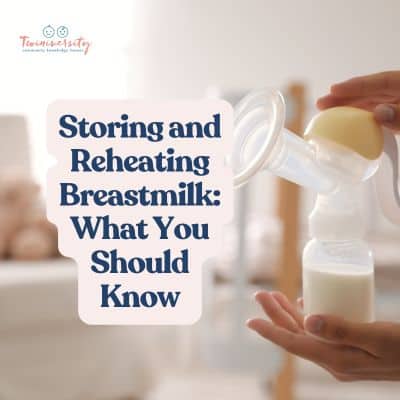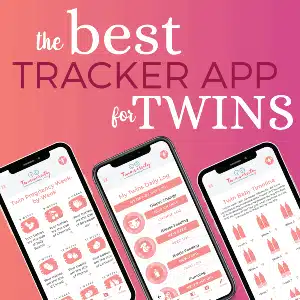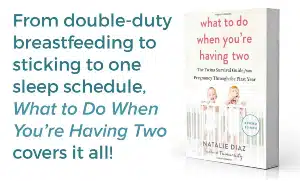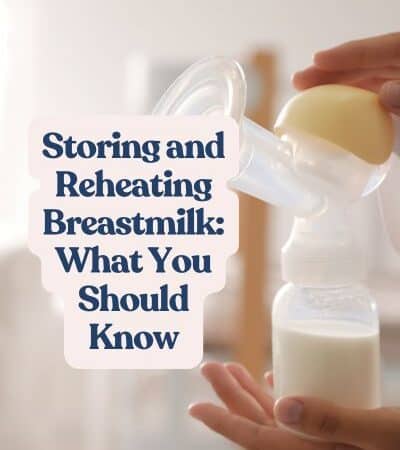
Whether you use an electronic or manual breast pump, here are the need-to-knows for safely storing and reheating breastmilk, thawing breast milk, and preparing frozen breast milk.
How do you handle breast milk? Not necessarily a table topic that comes up regularly. It’s more that type of information you don’t know you need to know until you’re IN IT.
Once your production fully kicks in after a few weeks, a lot of twin moms start to pump in conjunction with breastfeeding. This allows your body to keep up with the growing appetite of your babies and to have reserves on hand for bottle-feeding or for saving for future use.
You could try asking your mom or other wise moms who’ve been down this path to help you with some tips, but of course, sometimes the information they have could be outdated or forgotten (because early motherhood can be a blur, can’t it?!).

Got twins? Us too! The Twiniversity Podcast with Natalie Diaz was created BY parents of twins FOR parents of twins, from your pregnancy days through your twin’s teenage years, this podcast covers it all. It’s all about parenting twins, offering plenty of strategies for making life better, parenting hacks, and, of course, humor. We are laughing WITH you every step of the way.
Or perhaps you’ve already met with your hospital lactation specialist who gave you a quick rundown of breastmilk basics. But once you’re discharged from the hospital, it’s on you to figure out how to make breastfeeding, pumping, and storing breastmilk work.
The good news is storing and reheating breast milk doesn’t have to be complicated. After all, women have been feeding their babies with breastmilk since the beginning of time.
But just as with any other food or drink you consume, knowing the expiration date and shelf life is a good place to start. That’s why we wanted to share the essentials you need to know for safely handling and reheating your liquid gold so you can ensure your babies’ safety!
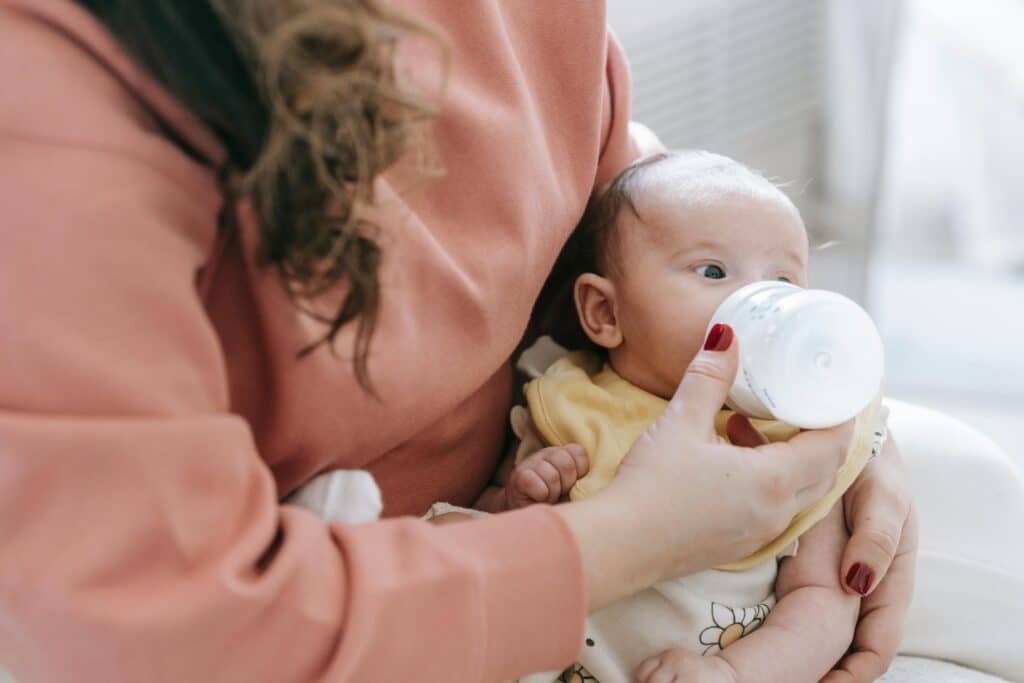
Breastmilk storage overview
Below is a summary of the latest guidance from experts like the CDC and the American Academy of Pediatrics (AAP) for how long you can safely store breastmilk at room temperature, in the fridge, and in the freezer.
| What you’re starting with | Can last at room temp. for… | Can be refrigerated for… | Can be frozen for… |
| Freshly expressed milk | Up to 4 hours | Up to 4 days | 6 – 9 months for a regular freezer 12 months for a deep freezer |
| Frozen/thawed milk | 1 – 2 hours | Ideally within 24 hours (from when it was completely thawed, not when you first move it to the fridge), but up to 48 -72 hours is okay | Never – should never refreeze previously frozen/thawed breastmilk |
But there’s probably a little more on your mind than just these numbers, so keep reading for a deeper dive!
Storing breastmilk safely
Whether your twins are your first babies or you’re already a seasoned parent, ensuring a clean environment is incredibly important for maintaining the safety of your babies’ primary source of food.
1. Everything should be clean and baby-safe!
First things first, wash your hands and start with clean pump parts. Then, make sure the breastmilk storing container or breastmilk storage bags you plan to use are clean.
A lot of baby bottle and breast pump brands sell their own version of breastmilk storage bags like Dr. Brown’s, Lansinoh, Mom Cozy, and Medela. These types of storage bags are great options since they are designed to be free of BPAs and harmful chemicals and specifically used for babies.
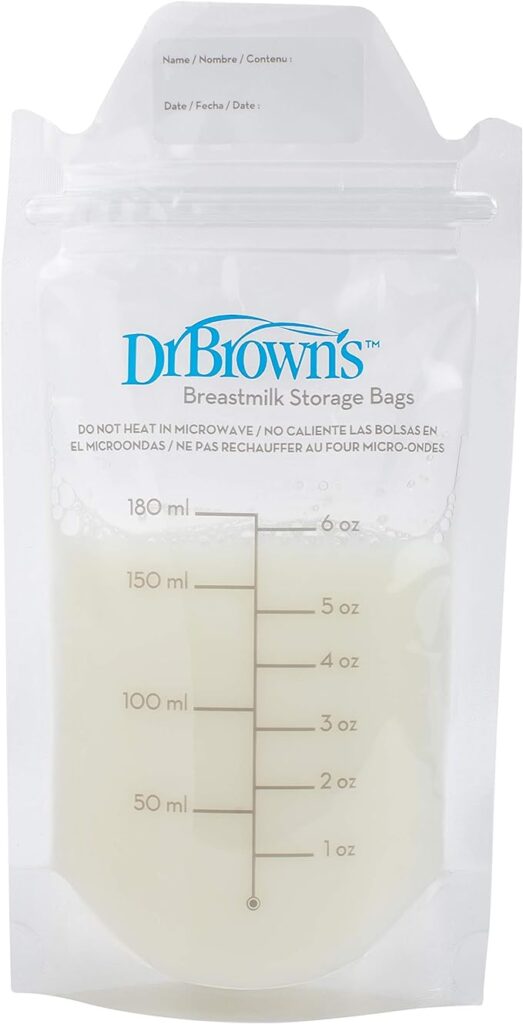
But there are other safe non-plastic options out there too like glass breastmilk storage bottles and silicone breastmilk storage bags and breastmilk cube trays (which could be great for when your twinnies are teething)!
One type of storage container to be careful of is those those plastic bottle liners (aka “drop-ins.”) I haven’t seen these in a very long time, but if you plan to use these, they aren’t recommended for safe breastmilk storage, thawing, and reheating. And if you have no idea what I’m talking about, that’s for the better, so just keep reading!
2. Decide where you will be storing the milk and for how long.
If you decide to use your pumped breastmilk that same day, you can store it in your refrigerator for up to 4 hours (according to the CDC). You can always check with your own pediatrician or lactation specialist for their best recommendations as well.
If you don’t plan to use your expressed milk that day, then label the storage bag or container with the date and time and freeze it right away.
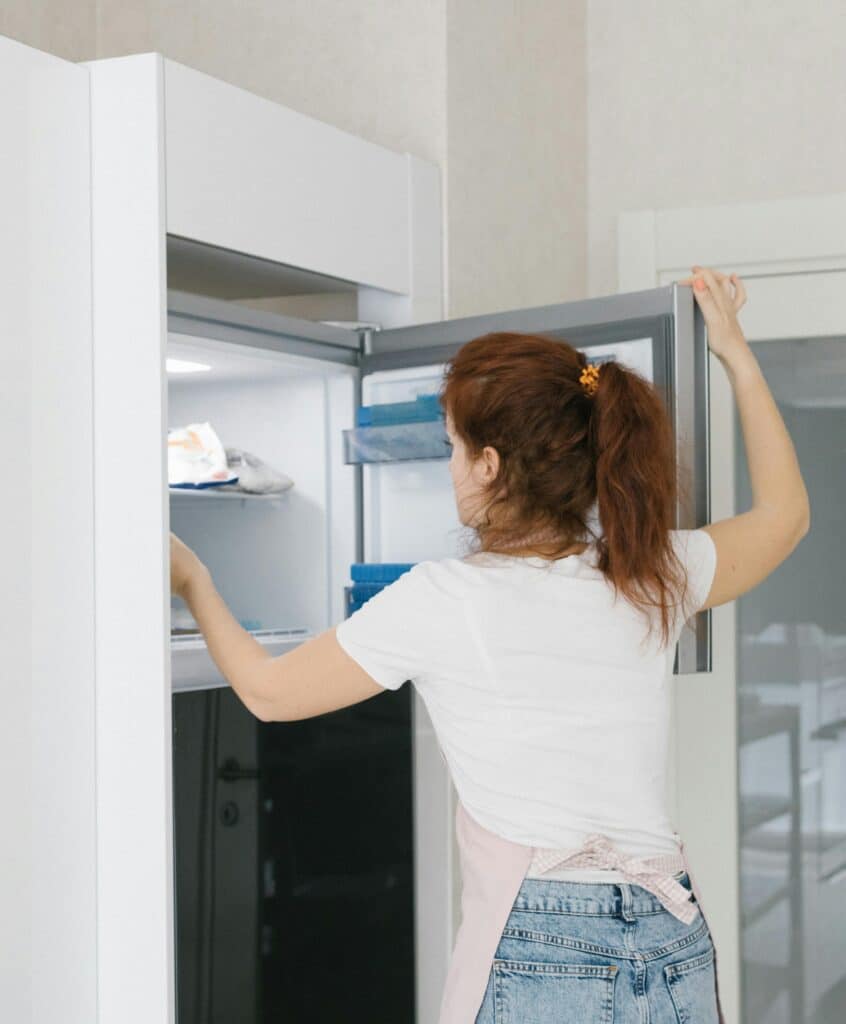
3. Placement matters!
If you will be using the freezer or fridge, it’s best to place the breastmilk more in the back or in a storage compartment that you don’t open as much. Why? Great question.
You know how your ice cream container that you keep in the front for easy access gets those weird frosty crystals after a while? That’s because the fluctuating temperature nearest the freezer door can cause freezer burn.
Think about it like this: the door is definitely the worst place to control temperature because you’re constantly opening and shutting the door. You can always check out the specific guidelines for your unique fridge or freezer. Whirlpool and other brands have great info on best use of their products on their sites.

4. Use a helpful labeling system!
The other rule of thumb with using breastmilk is the FIFO method (First In, First Out). That’s where labeling the correct date on your breastmilk storage bags or containers comes in handy. Since breastmilk has a shelf life, you want to use the oldest breastmilk first.
The one you expressed/pumped a week ago is already a week older than the one you just expressed and put away. Therefore, labeling is key!
It’ll help you remember when that bag was stored and keep you from having to throw out any expired bags. Breastfeeding is hard work, Mama! Your hard work should not be put to waste.
Lansinoh actually has a super helpful breastmilk storage container that’s first in, first out friendly and that provides extra freezer protection!
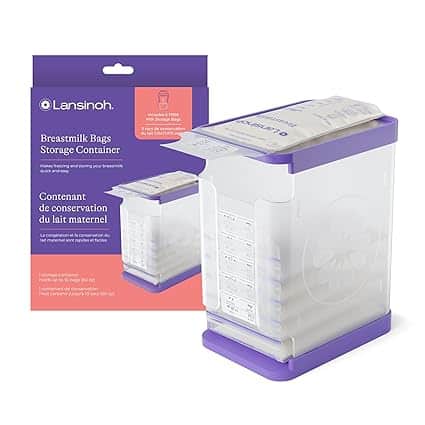
How to thaw breastmilk safely?
Okay, so let’s say you do plan to freeze some of your breastmilk, let’s talk about how to go from frozen breastmilk to milk you can serve your twinnies:
1. How do you thaw breast milk that is frozen?
Here are several safe ways you can thaw your frozen liquid gold:
- Plan ahead by putting it in the fridge overnight
- Thaw it under warm or room temperature running water
- Place the frozen bag/container in a bowl of warm (not hot) water
- Use the defrost function on your bottle warmer
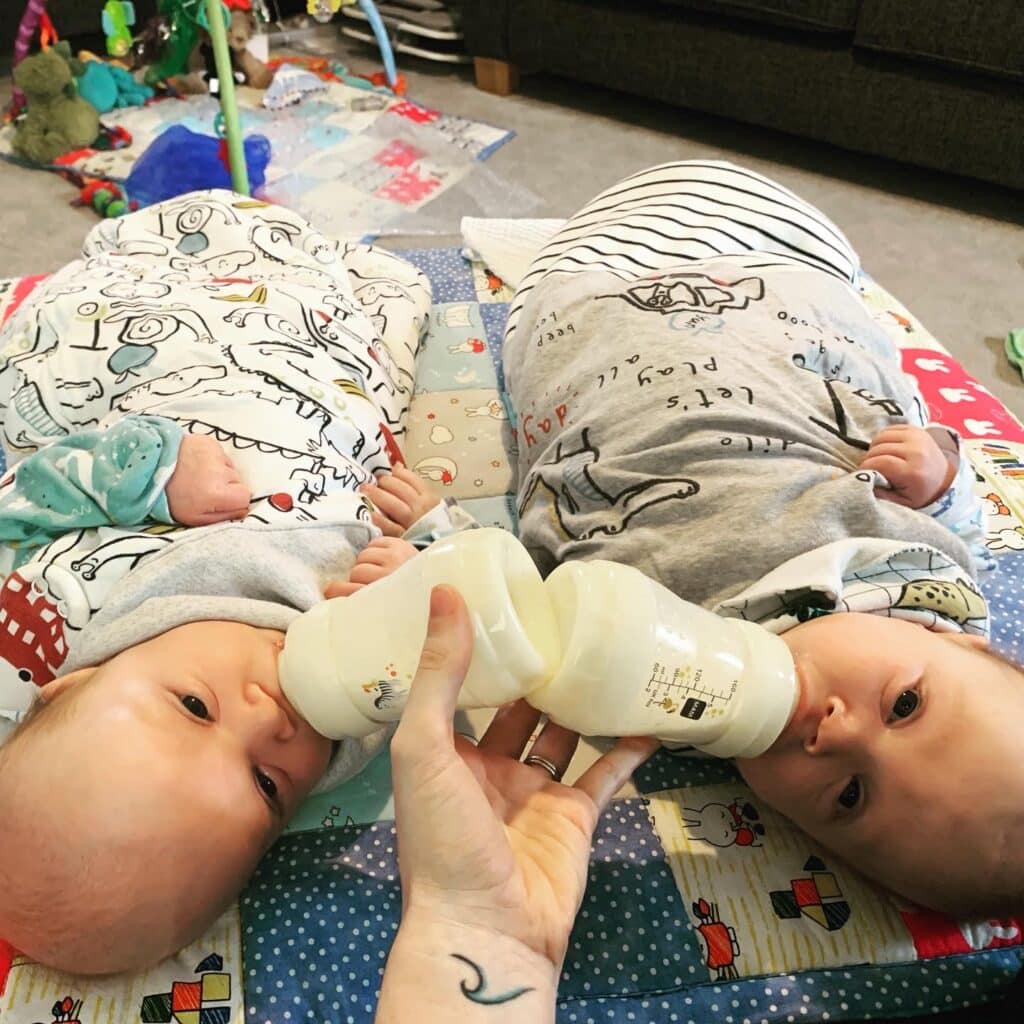
Want to learn more about bottle warmers? Check out this article: Double Bottle Warmer vs Single Bottle Warmer
2. Can you thaw and refreeze breastmilk?
This is a definite no! Once you’ve already thawed breastmilk, you cannot re-freeze it.
3. Can I microwave frozen breastmilk?
No, you should not microwave breastmilk, whether it’s been refrigerated or frozen.
This is because microwaves can cause the milk to heat unevenly and create “hot spots” that can scold your baby’s throat or mouth. If you’ve ever
4. Can breastmilk be reheated twice?
Once you’ve already reheated breastmilk, it’s best to avoid reheating it again. Reheating too much can strip the milk of its nutrients.
And after you’ve started bottle feeding your baby with the reheated milk, it’s best to discard it within 2 hours as bacteria can begin growing after that time.
What if I need to travel with breastmilk?
You can safely keep breastmilk in an insulated cooler with adequate ice packs for up to 24 hours. Just make sure once you reach your destination that you use it right away or store it in the fridge or freezer.
What if my baby doesn’t like the taste of thawed breastmilk?
Now that you’re a pro at safe breastmilk handling, what happens if your baby doesn’t like the taste of your breast milk after you’ve had it in the freezer?
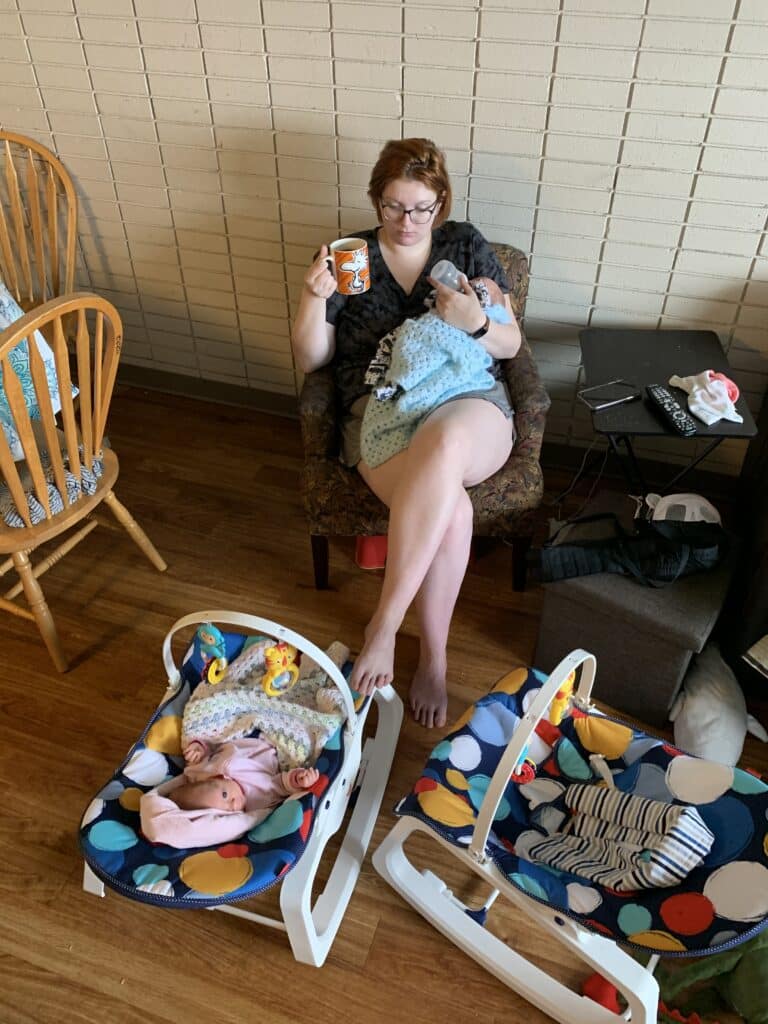
We all have seen the consistency of food be different once thawed. And breast milk is no different. Breastmilk also has an enzyme called lipase, which helps break down fats known as triglycerides. This breakdown keeps happening even when you freeze the milk.
This process helps ensure that “fat-soluble nutrients and fatty acids (which protect your baby from getting sick) are available to your little one” (Medela). These free fatty acids (FFAs) can have a funky taste to them though. And the longer it’s been since the milk has been expressed, the stronger the taste can get.
So what can you do to fix the taste?
Lipase is sensitive to heat. So if your baby rejects your milk due to the taste, here’s what you can do:
- After you pump the milk initially, scald it by heating it to 180 degrees Fahrenheit (not quite a rolling boil) over the stove or in your bottle warmer.
- Then let it cool and place it in the fridge or freezer to store it until ready to use.
If you’re worried about the high heat ruining the nutritional content, don’t. The process of scalding doesn’t change the nutritional value of breast milk. That said, it does eliminate active enzymes. This means it can strip the milk of antibodies that the baby would otherwise get from freshly expressed milk or nursing. But if it means your baby will actually drink your liquid gold instead of refusing it, it’s worth a try!
Takeaways for storing and reheating breastmilk safely
As you can see, handling breastmilk safely isn’t all that different from other safe food handling practices.
There are many baby brands that offer clean storage and sanitizing apparatuses as well to ensure your pumped/expressed milk is safe for your babies. If you have more concerns about how to make breastfeeding or pumping breastmilk work for you and your twins, it’s a good idea to check in with your pediatrician or a twin lactation specialist.
Want to learn more about safe bottle feeding, breastfeeding, and pumping? Check these out too:
- Cleaning Baby Bottles: Care Tips and Hacks for Twin Parents
- Double Bottle Warmer vs Single Bottle Warmer for Twins
- How to Hand Express Your Milk: The Ultimate Guide

Stephanie Miller is the proud mom of twin cyclones Zach and Carter. Every day in the Miller house, you’ll find rooms turned over, floors covered in bits of Lego and puzzle pieces (mind your step), and the sound of “Brown Bear Brown Bear” read over and over, and over again. You’ll typically find her being used as the seat to reading time for the two bookworms, covered in bubble solution as they try to excel in their Bubble Wand skills, or being the voice to command Alexa for their favorite tunes. She and her husband are working on their traveling skills cause she can’t wait to show them the amazing world that is out there for them.

